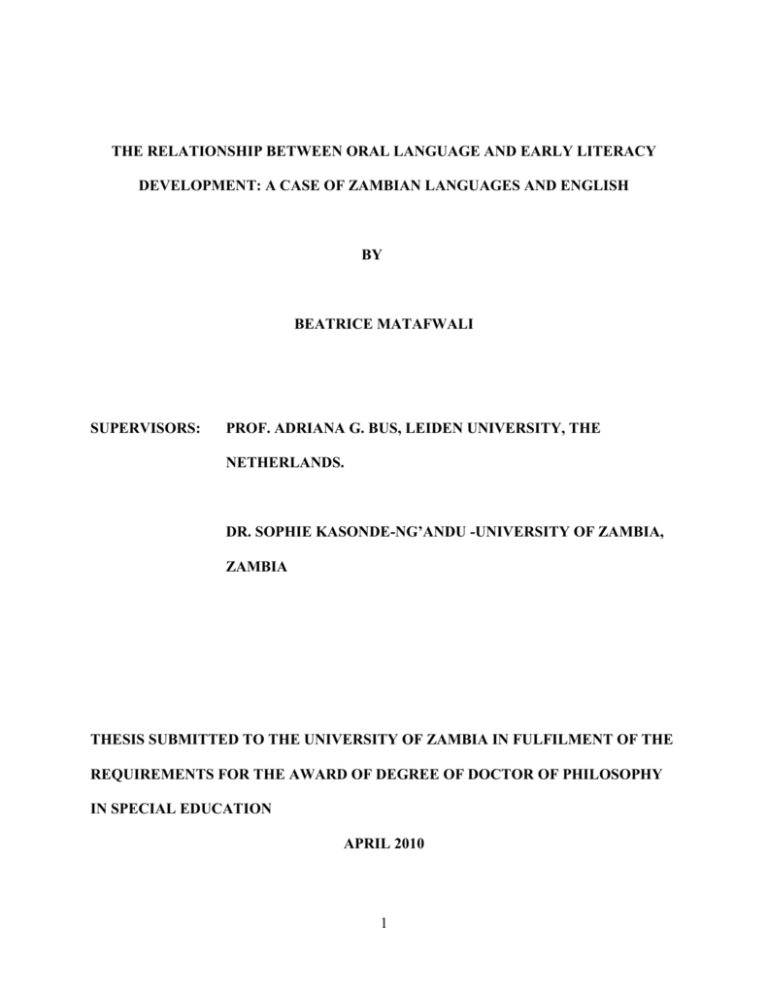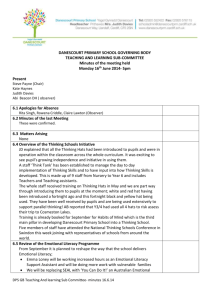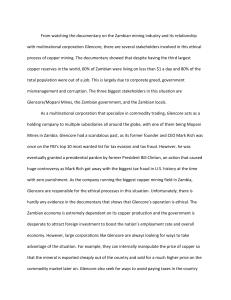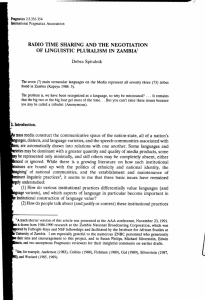Literacy and Language. Relationships in first and second grade.
advertisement

THE RELATIONSHIP BETWEEN ORAL LANGUAGE AND EARLY LITERACY DEVELOPMENT: A CASE OF ZAMBIAN LANGUAGES AND ENGLISH BY BEATRICE MATAFWALI SUPERVISORS: PROF. ADRIANA G. BUS, LEIDEN UNIVERSITY, THE NETHERLANDS. DR. SOPHIE KASONDE-NG’ANDU -UNIVERSITY OF ZAMBIA, ZAMBIA THESIS SUBMITTED TO THE UNIVERSITY OF ZAMBIA IN FULFILMENT OF THE REQUIREMENTS FOR THE AWARD OF DEGREE OF DOCTOR OF PHILOSOPHY IN SPECIAL EDUCATION APRIL 2010 1 ABSTRACT Reading is at the core of the educational experience and its ability is an essential key to success in our society. Unfortunately, a good number of Zambian children are reading below the expected grade level. These unfavorable literacy levels led the Zambian government to change the language policy in an effort to improve literacy standards in the country. A new literacy language policy called the Primary Reading Programme (PRP) was therefore, ushered in, with the New Break Through to Literacy (NBTL). This new language policy requires that children in Grade One are taught to read in a familiar language, preferably their mother tongue and that a shift is made to English in the Grade Two. However, despite the profound changes in the language policy, the reading levels of many Zambian pupils continue to be regrettably low (MoE, 2003, Matafwali, 2005, Ojanen, 2007). Currently, there is no empirical evidence to establish the causal factors underlying the persistent reading failure of Zambian children given the rich literacy programme in place. It is in this respect that the present study sought to establish the importance the importance of language to literacy development in order to examine how lack of proficiency in the language of instruction can help explain reading difficulties observed in the majority of school going children in Zambia. The study utilised two methodological approaches, cross sectional and longitudinal. The target population for the cross sectional sample comprised children enrolled in Grades One and Two from seven selected schools in Eastern, Northern, Southern, Western and North Western Provinces respectively. The target sample per school was 80 pupils giving a total of 557 (242 boys and 315 girls). Children were tested at the end of Grades One and Two respectively. The longitudinal sample comprised children enrolled in Grade One from six schools in Lusaka Province. The target sample per school was 24 pupils giving a total of 144 children. Children were tested at the end of Grade One. Follow-up testing (Phase II) commenced, approximately nine months after the initial testing was completed. Hundred and Six (106) of the children in the original sample were tested during Phase II. Children were tested individually. The tests were administered in the seven curriculum local languages for the cross sectional sample at both grade levels. Whereas for the longitudinal sample, Nyanja was applied in Grade One, and both Nyanja and English were applied in Grade Two. 2 To assess alphabetic knowledge and early literacy skills, the Basic Skills Assessment Tool (BASAT) was applied. The BASAT includes in addition to word recognition and text comprehension, tests to assess basic skills like letter knowledge, phonemic awareness and shortterm memory. Familiarity with language was tested using narrative test, storytelling as measures of expressive vocabulary and the Peabody Picture Vocabulary Test and a test of syntactic knowledge measured receptive vocabulary. Picture completion (WISC-R), Block construction (NEPSY) and Pattern Reasoning (Kauffman Test Battery for Children) were utilised to measure non verbal cognitive abilities. Interview with children and teacher questionnaire elicited qualitative data. A variety of methods were used to analyze the data including, correlation, hierarchical regression and logistic regression. Conclusion Language proficiency was a strong predictor (β= .52) and accounted for 25% of the variance. After entering alphabetic knowledge, language continued to be a strong predictor, albeit much weaker (β= .24). Alphabetic knowledge accounted for 25% of the variance and language proficiency for 6% of the total variance. The findings of the present study support the hypothesis that both language and alphabetic skills are independent predictors of reading, albeit that in this early stage alphabetic knowledge is a stronger predictor. The longitudinal effects of oral language were also found in this study even when cognitive and background factors are taken into account. Overall, results supported the expectation that reading proficiency was low. Surprisingly, pupils from Grade Two did not out perform pupils from Grade One in basic skills and reading proficiency. Development of reading skills seem to somewhat discontinue in Grade Two when a shift is made from practicing in the Zambian language toward practicing in English. Probably also as a result of a dearth of age-appropriate reading materials in the Zambian languages reading stagnates. 3 Recommendations Based on the findings of the study, the following recommendations were made: 1. Strengthen the initial language of instruction by extending the practice to Three years so that children can do their first years of schooling in the mother tongue. 2. The issue of what constitutes mother tongue should be clarified. 3. Ministry of Education to strengthen training of teachers in early literacy skills. 4. Collaboration between home and school environment need to be enhanced so that parents/caregivers get actively involved in literacy activities for their children. 4









